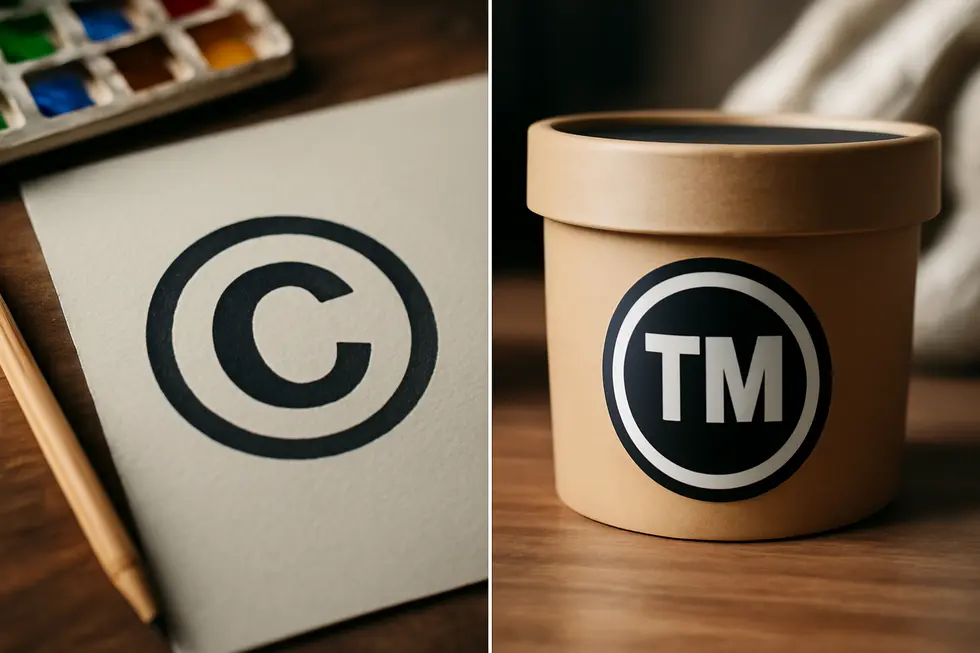Introduction
Protecting the elements that define your brand is essential for long-term business success. While many business owners hear the term “copyright” and naturally associate it with protecting creative works, it’s important to understand that names and logos require a different form of protection—trademark registration. Distinguishing between copyright and trademark is the first step to safeguarding your business’s unique identifiers. This comprehensive guide breaks down the legal distinctions in Chapter 1, walks you through the step-by-step trademark registration process for names and logos in Chapter 2, and covers practical considerations, costs, and the legal benefits of securing trademarks in Chapter 3. By the end, you’ll understand exactly how to protect your name and logo properly to build a strong, legally protected brand.
Tables of Contents
Chapter 1: How to Copyright a Name and Logo: Understanding the Legal Distinction Between Copyright and Trademark Protection
- Securing Brand Identity: The Essential Role of Trademark Protection for Names and Logos
- Unveiling Copyright’s Impact on the Artistic Design Within Names and Logos
- Navigating the Trademark Registration Process for Names and Logos: Essential Steps to Secure Brand Rights
Chapter 2: How to Copyright a Name and Logo: Step-by-Step Process of Trademark Registration for Names and Logos
- Mastering Trademark Searches: Ensuring Your Name and Logo Are Clear for Registration
- Preparing and Filing Your Trademark Application: Essential Steps for Protecting Your Name and Logo
- Navigating USPTO’s Examination, Opposition, and Maintenance Stages in Trademark Registration
Chapter 3: How to Copyright a Name and Logo: Practical Considerations, Costs, and Legal Benefits of Trademark Registration
- Key Practical Steps for Securing Trademark Protection of Your Name and Logo
- Unpacking the Financial Commitment: A Detailed Cost Breakdown for Trademarking Your Name and Logo
- Unlocking the Power of Trademark Registration: Legal Protections That Secure Your Name and Logo
Chapter 1: How to Copyright a Name and Logo: Understanding the Legal Distinction Between Copyright and Trademark Protection

1. Securing Brand Identity: The Essential Role of Trademark Protection for Names and Logos
Trademark protection serves as the cornerstone for legally safeguarding brand identifiers such as names, logos, slogans, and distinctive symbols that differentiate one business’s goods or services from another’s. Unlike copyright, which only covers the original creative expression fixed in a tangible medium, trademark law specifically targets elements that communicate brand identity and prevent consumer confusion in the marketplace.
Registering a trademark involves a formal application process through agencies like the United States Patent and Trademark Office (USPTO). This process ensures your name or logo is unique and not infringing upon existing marks. A comprehensive trademark search is a crucial first step, as it uncovers potential conflicts and reduces the risk of legal disputes or application refusals. Since names and logos represent separate aspects of brand identity, they require distinct trademark registrations, each carefully describing the mark’s design elements and the goods or services it covers.
Trademark protection, when secured, grants the exclusive right to use the ® symbol, signaling federal registration and stronger enforcement capabilities. Prior to registration, the ™ symbol may be used to assert claim over the mark under common law rights, but these are more limited. Registered trademarks provide indefinite protection as long as they are actively used and properly maintained through renewals, a notable advantage over copyright’s fixed-term duration.
This legal protection enables businesses to prevent others from using confusingly similar names or logos, which could harm brand reputation and consumer trust. For instance, software companies can trademark product names and logos to preserve their brand recognition—while copyright protects the software code itself, trademark safeguards the brand’s identity in the marketplace.
For those seeking detailed guidance on trademark registration and maintaining brand protection, consulting specialized legal resources or professionals is highly advisable. More information on this process can be found at resources like trademark protection for business names and logos.
Ultimately, trademark registration is an indispensable legal tool to protect names and logos, distinguishing them clearly from copyright, which protects the artistic or literary content but not the branding elements themselves.
2. Unveiling Copyright’s Impact on the Artistic Design Within Names and Logos
While many seek to “copyright” a name or logo, it’s critical to understand copyright law’s specific role in protecting the artistic components rather than the brand itself. Copyright safeguards original creative expressions fixed in a physical form—this includes unique drawings, graphic illustrations, and artistic elements within a logo. For instance, if a logo incorporates a custom illustration or distinctive graphic style, copyright shields these elements from unauthorized copying or distribution as an original work of authorship.
However, copyright does not extend protection to the name or logo as a commercial source identifier. Names and logos function in commerce to identify and distinguish goods or services, which is the exclusive realm of trademark law. Trademark protection prevents others from using confusingly similar marks that could mislead consumers and dilute brand identity. Thus, copyright and trademark serve complementary but distinct purposes: copyright preserves the creative artistry behind logo designs, while trademark protects their use as symbols of business origin.
This distinction also affects the registration process. Copyright protection arises automatically upon creation and fixation of the artwork, without requiring formal registration. In contrast, trademark rights depend on use in commerce and, for enhanced protection, registration through the United States Patent and Trademark Office (USPTO). Notably, the ability to simultaneously hold both copyright and trademark rights for a logo strengthens overall legal protection—copyright defends the artistic originality, while trademark controls exclusive commercial use.
Understanding these boundaries ensures proper legal strategy. Protecting the original artwork properly with copyright deters unauthorized artistic reproduction, but securing trademark registration is essential to claim exclusive rights over the logo’s brand identity in the marketplace. For those navigating this complex interface, insightful resources on trademark protection for business names and logos offer valuable guidance to clarify these legal distinctions and effective protection methods.
3. Navigating the Trademark Registration Process for Names and Logos: Essential Steps to Secure Brand Rights
Protecting a business name and logo involves securing trademark rights rather than copyright, as trademarks legally safeguard the unique identifiers of your brand in commerce. The journey begins with a thorough trademark search to confirm that your chosen name and logo are not identical or confusingly similar to any existing trademarks. This crucial step reduces the risk of costly legal disputes and application refusals later in the process.
Once uniqueness is established, you must carefully prepare separate trademark applications for your name (wordmark) and your logo (design mark), or choose a composite mark combining both elements. Each application must clearly describe the mark, specify associated goods or services, and state the basis for filing—whether it’s actual use in commerce or intent to use in the future. These details form the foundation of your trademark registration and help define the scope of your protection.
Filing is done online through the United States Patent and Trademark Office (USPTO). After submission, a thorough examination by USPTO reviews your application to ensure compliance with trademark laws and absence of conflicts with prior marks. If approved, your mark is published publicly for a designated opposition period, during which third parties may challenge your registration if legitimate concerns arise.
Upon passing the opposition phase, your trademark is registered federally, granting you the exclusive right to use the mark nationwide and to display the ® symbol. Maintaining these rights demands ongoing commercial use of the mark and filing renewal documents at regular intervals to prevent abandonment. Without registration, you may still have common law rights, but these offer much weaker protection compared to federal registration.
While copyright protects the artistic elements that may appear in a logo design, it does not cover the name or the brand-identifying function of the logo. To secure strong, enforceable rights for your entire brand identity, trademark registration is the essential legal tool. For those navigating these complexities, consulting an intellectual property attorney can streamline the process and enhance your chances of successful registration.
More insight on protecting your brand identity can be found at trademark protection for business name and logo.
Chapter 2: How to Copyright a Name and Logo: Step-by-Step Process of Trademark Registration for Names and Logos

1. Mastering Trademark Searches: Ensuring Your Name and Logo Are Clear for Registration
Protecting a name and logo begins with a critical and thorough trademark search to avoid costly legal conflicts. Since trademarks safeguard brand identifiers rather than copyright, the first step in the registration process is determining whether your desired name or logo is available for use. This involves exploring the United States Patent and Trademark Office (USPTO) database, as well as relevant national databases if you plan broader protection. By examining existing trademarks and pending applications, you reduce the risk of rejection due to conflicts.
Searching goes beyond simple keyword lookups. For names, it is essential to check variant spellings, phonetic equivalents, and similar word combinations that might cause confusion. For logos, the search becomes more nuanced; design codes are employed to classify fonts, colors, shapes, and other elements to find potentially conflicting designs. The USPTO’s Trademark Electronic Search System (TESS) offers flexible search options, including “Word/Design Mark Search,” which allows users to combine word and design elements for comprehensive results.
Selecting the correct trademark class is equally important. Trademarks register within specific classes that reflect the goods or services your brand represents. This classification directs the search scope and informs the subsequent application. An incorrect class may limit protection or trigger office actions during examination.
Once a clear trademark search confirms no similar or identical marks exist, you can proceed with filing your application. The application details your name or logo, design attributes, and associated business categories. Should any objections arise during examination, timely and well-prepared responses are necessary to address the USPTO’s concerns, often with legal guidance.
Effective trademark searches are key to a successful registration, saving both time and money by preventing clashes with pre-existing marks. Many applicants choose to utilize professional search and filing services to navigate these complexities. Understanding how to conduct a thorough search yourself can empower you to take confident first steps toward securing your brand’s exclusive rights.
For more insight on trademark protection for names and logos, visit the detailed guide on trademark protection business name logo.
2. Preparing and Filing Your Trademark Application: Essential Steps for Protecting Your Name and Logo
Preparing and filing a trademark application requires careful attention to detail to secure exclusive rights for your name and logo. Unlike copyright, which does not protect brand identifiers like names or logos, trademark registration provides this key legal safeguard. Before submitting an application, a comprehensive trademark search is critical. This step ensures the name or logo is unique and avoids conflicts with existing registrations. The search involves examining exact and variant spellings of your name, as well as analyzing logo design elements using official trademark design codes. This thorough groundwork reduces the risk of rejection and infringement disputes.
Once uniqueness is confirmed, the next pivotal decision involves selecting the correct class or classes from the internationally recognized Nice Classification system. Each class corresponds to a category of goods or services your trademark will cover. Since each class requires a separate filing and fee, it is important to identify where your business activities fit precisely. This classification ensures your trademark protection is tailored and enforceable within relevant industries.
The application itself must be prepared meticulously, describing the trademark in detail. For names, this includes the exact wording and any stylization. For logos, every design element—such as colors, shapes, and fonts—should be clearly outlined to avoid ambiguity. Additionally, specifying the goods and services associated with the trademark is essential to define the scope of protection clearly.
Submission of the application is made to the United States Patent and Trademark Office (USPTO) or equivalent national authorities. Filing fees typically start between $250 and $350 per class, with additional charges possible for further processing. The examination process often takes six to twelve months during which the trademark office may issue inquiries or objections. Responding promptly and thoroughly to these office actions is vital, and legal counsel can assist in navigating challenges effectively.
After approval, your registered trademark allows you to display the ® symbol, a powerful indicator of federal protection. Maintaining this protection requires timely renewals and declarations. For a more streamlined experience and to improve approval chances, consulting trademark experts or specialized services can be invaluable.
For a comprehensive understanding of trademark protection for your name and logo, including detailed procedures and legal nuances, see this resource on trademark protection for business names and logos.
3. Navigating USPTO’s Examination, Opposition, and Maintenance Stages in Trademark Registration
Registering a trademark for a name or logo with the USPTO is a thorough process involving three critical phases: examination, opposition, and maintenance. Once you file your application, a USPTO examining attorney scrutinizes it to confirm compliance with legal standards. This review centers on confirming the mark’s distinctiveness and checking for conflicts with existing registrations or pending applications. If any issues arise, such as descriptiveness or similarity to prior marks, the USPTO issues an office action outlining refusals or required corrections. Responding effectively to these office actions often demands a strategic presentation of evidence or legal arguments, sometimes demonstrating acquired distinctiveness to overcome objections.
When the examining attorney approves your application, it enters the opposition stage. The USPTO publishes your mark in its Official Gazette for a 30-day window, during which third parties with legitimate concerns may oppose your registration. Oppositions can delay or block your trademark if valid and unresolved in your favor. Successfully navigating this period requires careful handling and may involve legal counsel to address any challenges posed by competitors or related trademark owners.
After surviving opposition, your trademark moves to registration, but the protection is not permanent without active maintenance. Federal trademark law mandates periodic filings to prove ongoing commercial use—typically between the fifth and sixth years after registration, and then every ten years. Failure to submit these maintenance documents on time can result in cancellation, losing the robust protection that federal registration affords. Maintaining your trademark registration secures exclusive rights that empower you to prevent unauthorized use by others.
Understanding this process is essential for anyone seeking lasting protection of a business name or logo. The intricate examination and opposition stages ensure only distinctive marks gain registration, while maintenance keeps these rights enforceable long term. For a deeper insight into the nuances of trademark protection, explore our detailed guidance on trademark protection for business names and logos.
Chapter 3: How to Copyright a Name and Logo: Practical Considerations, Costs, and Legal Benefits of Trademark Registration

1. Key Practical Steps for Securing Trademark Protection of Your Name and Logo
Successfully protecting your brand’s name and logo starts with understanding that trademark registration—not copyright—is the proper legal tool. The journey begins with a thorough trademark search using the USPTO’s Trademark Electronic Search System (TESS). This step checks whether your intended name or logo conflicts with existing marks, reducing risks of rejection or infringement. Early filing is critical; submitting your application before launching your brand secures priority rights and prevents others from registering similar marks.
Selecting a distinctive, unique name or logo is essential because generic or descriptive marks often face refusal. Crafting a strong trademark requires attention to design details like fonts, colors, and shapes since these elements will be officially described in your application. Equally important is correctly identifying the right trademark classes that cover your specific goods or services; misclassification can cause delays or complicate enforcement.
The application must be carefully prepared, including clear images of the logo and precise descriptions of the associated products or services. You must also indicate whether you are already using the mark in commerce or intend to do so. Expect the filing fees to range from $250 to $350 per class, accompanied by potential costs for legal assistance or later renewals. The entire process typically takes six to twelve months.
After registration, maintaining your trademark is vital—use it consistently, monitor for unauthorized use, and file timely renewals to retain protection. While legal counsel is optional, consulting a trademark attorney can help navigate complex issues and increase the likelihood of approval.
Remember, copyright protects artistic and literary creations, not brand identifiers like names or logos. For effective protection of your brand’s identity, trademark registration is the necessary step. For further insights on distinguishing trademark protection from copyright, exploring resources like this detailed guide on trademark protection of business names and logos can be invaluable.
2. Unpacking the Financial Commitment: A Detailed Cost Breakdown for Trademarking Your Name and Logo
Securing federal trademark protection for a name and logo entails a variety of costs that reflect the complexity and importance of legally safeguarding your brand identity. The largest and most immediate expense comes from the United States Patent and Trademark Office (USPTO) filing fees. These fees generally range from $225 to $400 per class of goods or services associated with your mark. Since trademarks are classified according to the specific types of products or services they cover, filing for multiple classes multiplies this cost accordingly. For example, registering a logo for both clothing and cosmetics requires fees for two separate classes.
Beyond USPTO fees, engaging an experienced trademark attorney is a common practice to streamline the process and reduce the likelihood of application errors or refusals. Attorney fees for basic trademark registration support typically fall between $1,000 and $2,000, though more complex cases or legal disputes during registration can increase costs substantially, sometimes reaching $300 to $400 per hour. Despite the expense, professional guidance is often invaluable for navigating the legal intricacies and responding to office actions or oppositions.
Additional USPTO fees arise during the trademark’s lifecycle, including post-filing procedures such as declarations of use, extensions, and renewals. These maintenance-related fees can range from $100 to $525, ensuring ongoing protection as long as the trademark remains active and correctly used in commerce. Remember, trademarks require periodic renewals to avoid abandonment.
For those on a tighter budget, self-filing is an option to reduce upfront costs, but it demands careful adherence to regulations to avoid application pitfalls. Likewise, specialized trademark services offer a middle ground, assisting with filings for additional fees.
Anticipate a total initial investment starting around $750, covering basic filing expenses, with costs comfortably reaching $2,500 or more when including professional assistance and multiple classifications. Approval typically takes 6 to 12 months, reflecting the rigorous examination process.
By understanding these costs, applicants can better prepare financially to achieve strong legal protection for their brand’s name and logo. For more information on trademark protection essentials, consider exploring comprehensive guides on trademark protection for business names and logos.
3. Unlocking the Power of Trademark Registration: Legal Protections That Secure Your Name and Logo
Trademark registration is a vital legal tool for securing exclusive nationwide rights to your name and logo, offering robust protections that common law rights simply cannot match. By registering your trademarks, you gain the legal presumption of ownership, which serves as powerful evidence in any infringement disputes, making it easier to enforce your rights in court. Unlike unregistered marks limited to specific geographic regions, a federally registered trademark safeguards your brand across the entire country, minimizing the risk of confusingly similar uses by competitors.
One key benefit is the right to use the ® symbol. This officially signals your registered status to consumers and potential infringers, deterring unauthorized use and helping preserve your brand’s distinctiveness. Beyond mere deterrence, registration empowers you to take stronger legal action, including suing for infringement in federal court and enlisting U.S. Customs to intercept counterfeit or infringing goods at the border.
Trademarks are not only protective legal rights but also valuable business assets. They contribute to your company’s goodwill and market recognition, making them licensable and even sellable properties that can add significant financial value. Maintaining your trademark through timely renewals and consistent use is essential to sustain these protections and keep your brand shield intact.
Proactive enforcement is another critical advantage. Registered trademarks facilitate monitoring for unauthorized usage and provide a clearer legal pathway for addressing infringements before they erode your brand’s reputation or market share. This creates a foundation for long-term brand security and business growth.
It’s important to distinguish trademark protection from copyright: while copyright protects original creative works, it does not extend to names or logos. Thus, trademark registration remains the preferred method for securing these essential brand identifiers.
For deeper insights into how trademarks safeguard your business name and logo, exploring resources on trademark protection for business names and logos offers practical guidance tailored to these aspects.
Final thoughts
Understanding how to protect a name and logo through trademark registration rather than copyright is essential for any business owner intent on safeguarding their brand. Clear legal distinctions highlight why copyright does not apply to names or logos and why trademark registration is the proper pathway. Following a detailed step-by-step approach ensures your applications for names and logos are robust and comprehensive, minimizing risks of rejection or future conflicts. Moreover, knowing the practical considerations, associated costs, and the significant legal advantages encourages informed decisions that strengthen your brand’s position in the marketplace. By securing trademark protection, you establish a solid foundation for your business identity and access enforceable rights against infringement, ultimately enhancing your brand’s value and longevity.
Your IP is the foundation of your success – let’s protect it together before it’s too late. We can’t wait to help you turn your ideas into legally secured assets.
About us
undefined


